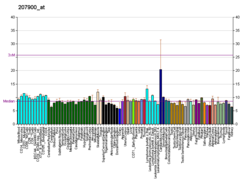CCL17 is a powerful chemokine produced in the thymus and by antigen-presenting cells like dendritic cells, macrophages, and monocytes.[5] CCL17 plays a complex role in cancer. It attracts T-regulatory cells allowing for some cancers to evade an immune response.[6] However, in other cancers, such as melanoma, an increase in CCL17 is linked to an improved outcome.[6] CCL17 has also been linked to autoimmune and allergic diseases.[7]
- ^ a b c GRCh38: Ensembl release 89: ENSG00000102970 – Ensembl, May 2017
- ^ a b c GRCm38: Ensembl release 89: ENSMUSG00000031780 – Ensembl, May 2017
- ^ "Human PubMed Reference:". National Center for Biotechnology Information, U.S. National Library of Medicine.
- ^ "Mouse PubMed Reference:". National Center for Biotechnology Information, U.S. National Library of Medicine.
- ^ Lacy P (2017). "Eosinophil Cytokines in Allergy". Cytokine Effector Functions in Tissues. Elsevier. pp. 173–218. doi:10.1016/b978-0-12-804214-4.00011-7. ISBN 978-0-12-804214-4.
- ^ a b Cite error: The named reference
Korbecki_2020was invoked but never defined (see the help page). - ^ Cite error: The named reference
Ness_2006was invoked but never defined (see the help page).





